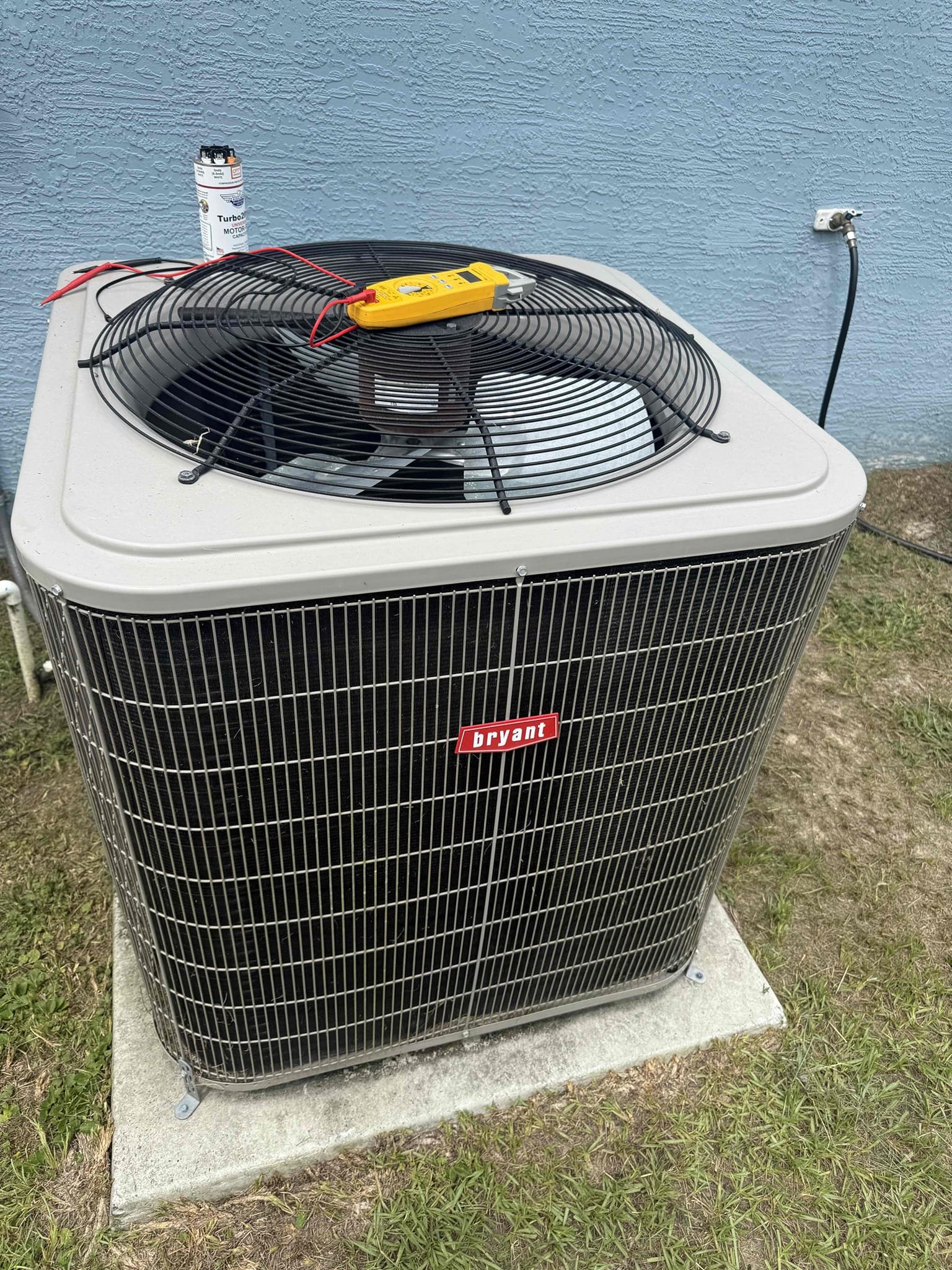


FREE Water Heater
With every whole house repipe purchase. Free brand-new water heater or credit towards a tankless water heater.
.svg)
.svg)
.svg)
.svg)



With every whole house repipe purchase. Free brand-new water heater or credit towards a tankless water heater.
.svg)
.svg)
.svg)
.svg)

When your air conditioner breaks down in the middle of summer, it can turn your home into an unbearable furnace within hours. Emergency AC repair services are available 24/7 to restore cooling when your system fails completely, poses safety risks, or creates urgent comfort issues. Most major cities offer round-the-clock HVAC technicians who can diagnose problems and provide immediate solutions.
Not every AC problem requires emergency service, and homeowners can save money by understanding which issues need immediate attention versus those that can wait until regular business hours. Simple troubleshooting steps might resolve minor problems without calling a technician at all.
Emergency repair visits typically include full system diagnostics, immediate fixes when possible, and clear explanations of repair costs and timelines. In this article, you’ll learn when emergency AC repair is necessary, how to troubleshoot basic issues, and what to expect from 24/7 HVAC services.
Below, we’ll walk through each important aspect.
Keep reading! Knowing what to expect from emergency service calls, how to choose reliable technicians, and basic prevention tips can help homeowners stay cool and avoid future breakdowns.
Some AC problems need immediate attention while others can wait for regular business hours. True emergencies involve safety risks, extreme temperatures, or potential property damage.
Complete AC failure during extreme heat poses serious health risks. When temperatures reach 90°F or higher, homes can become dangerous quickly. Vulnerable people like elderly adults, young children, and those with medical conditions face the highest risk.
Burning smells require immediate action. This often means electrical problems or overheated components. Turn off the AC right away and call for emergency service. These issues can cause fires if ignored.
Water leaking near electrical components creates shock and fire hazards. This happens when drain pans overflow or coils freeze and melt. The combination of water and electricity is always dangerous.
Signs that need emergency service:
A frozen evaporator coil stops cooling completely. Ice forms when airflow drops or refrigerant levels fall too low. This problem gets worse over time and can damage the compressor.
Loud grinding or metal-on-metal sounds mean parts are breaking down. These noises often come from failing motors or loose components. Continued operation can cause expensive damage to other parts.
Short cycling means the AC turns on and off every few minutes. This wastes energy and strains the system. Common causes include dirty filters, low refrigerant, or electrical problems.
These issues can usually wait until morning:
Open windows at night when temperatures drop. Close them in the morning to trap cool air inside. This works best when nighttime temperatures fall below 75°F.
Use fans to move air around the house. Ceiling fans should spin counterclockwise in summer. Box fans in windows can pull cool air in or push hot air out.
Safe cooling methods:
Portable AC units can cool single rooms temporarily. Make sure electrical circuits can handle the extra load. Never use outdoor generators inside the house.
Simple troubleshooting steps can often fix common AC problems before calling for expensive emergency service. Checking basic settings, power sources, and maintenance items takes just minutes but can save hundreds in service fees.
The thermostat controls the entire AC system, so checking it first makes sense. Many service calls result from simple thermostat issues that homeowners can fix themselves.
Temperature and mode settings need verification first. The thermostat should be set to "cool" mode and the temperature should be at least 5 degrees below the current room temperature. Some thermostats have a "heat" and "cool" switch that might be in the wrong position.
Battery replacement fixes many thermostat problems. Low batteries cause erratic behavior or complete system shutdown. Most thermostats use AA or AAA batteries that need changing once or twice per year.
Schedule programming might prevent the AC from running when expected. Many programmable thermostats have complex schedules that override manual settings. Switching to manual mode or checking the programmed times often solves the problem.
The thermostat's display should show clear, bright numbers. Dim or flickering displays usually mean dead batteries. No display at all might indicate a wiring problem that needs professional attention.
Electrical problems and blocked airflow cause most AC emergencies. These checks take less than 10 minutes and fix many common issues.
Circuit breakers trip when the AC system draws too much power. Check the main electrical panel for any breakers in the "off" or middle position. AC systems often use two breakers - one for the indoor unit and one for the outdoor unit. Flip tripped breakers fully off, then back on.
Disconnect switches near the indoor and outdoor units might be turned off accidentally. These look like light switches and should be in the "on" position. Someone might have turned them off during maintenance or cleaning.
Air filters block airflow when dirty, causing the system to freeze up or shut down. Remove the filter and hold it up to light. Replace it if light cannot pass through easily. Extremely dirty filters can cause expensive compressor damage.
Return vents throughout the house need to stay open and unblocked. Furniture, curtains, or closed vents reduce airflow and make the system work harder.
The outdoor unit needs proper airflow and drainage to work correctly. Simple maintenance checks prevent many emergency service calls.
Debris removal around the outdoor unit improves performance. Clear leaves, grass, and dirt from around the unit. The area within 2 feet should be completely clear of plants, fencing, or stored items.
Coil cleaning helps when the outdoor coils look dirty or clogged. Spray the coils gently with a garden hose from the inside out. Avoid using pressure washers that can damage the thin metal fins.
Drain line clogs cause water backup and system shutdown. The drain line usually exits near the outdoor unit or foundation. Pour a cup of white vinegar down the drain line to clear minor clogs. Water should flow freely from the end of the drain pipe.
Ice formation on the outdoor unit means the system needs to be turned off completely. Let all ice melt before restarting the system. Ice usually indicates low refrigerant or airflow problems that need professional repair.
Airflow issues, caused by clogged filters or blocked vents, can cut system efficiency by up to 15 percent, according to ENERGY STAR.
Emergency air conditioner repair technicians focus on three main priorities when they arrive: getting your system safe and working temporarily, making quick fixes when possible, and helping you decide between repair and replacement using cost guidelines.
The technician starts by checking for immediate safety risks. They look for electrical problems, gas leaks, or water damage that could harm your family or home.
Next, they run quick tests on major parts. This includes checking the compressor, electrical connections, and refrigerant levels. Most emergency visits focus on getting basic cooling back within the first hour.
Safety checks include:
The technician explains what they find in simple terms. They tell you if the system is safe to run and what temporary fixes they can make right away.
They also give you a clear timeline. You'll know if they can fix it today or if you need to wait for parts. This helps you plan for hotels or other cooling options if needed.
Many hvac repair emergency calls get fixed with simple part swaps. Technicians carry common parts on their trucks for same-day repairs.
Most common quick fixes:
Capacitor replacement takes about 15 minutes. These parts cost $20-50 and fix systems that won't start or run poorly.
Contactor replacement also happens fast. Bad contactors cause clicking sounds or prevent the system from turning on.
Drain clears solve water backup problems. Technicians use special tools to remove clogs that shut down your system.
These repairs usually cost $150-400 total. The technician can often complete them during the emergency visit without ordering parts.
The $5000 rule helps you make smart choices during emergency visits. You multiply your system's age by the repair cost to get a comparison number.
How the rule works:
For example, a 12-year-old system needing $600 in repairs equals 7,200. This suggests replacement might be better.
A 5-year-old system needing $800 in repairs equals 4,000. This points toward repair as the smart choice.
The technician discusses your system's remaining life expectancy. Older systems often need more repairs within months of emergency fixes.
They also explain energy savings from new systems. Modern units use 20-40% less electricity than systems over 10 years old.
This rule gives you a clear framework during stressful emergency situations. You can make confident decisions without pressure or confusion.
Emergency AC calls typically cost 50-150% more than regular service visits, with most repairs taking 2-6 hours depending on parts availability. Simple cooling strategies can help maintain comfort during the wait.
Emergency AC repair costs range from $200 to $800 for most common problems. After-hours service calls add $75 to $200 in surcharges.
Factors that increase emergency repair costs:
Simple repairs like thermostat replacements cost $150-300 during emergencies. Complex issues involving compressors or electrical systems can reach $500-800.
Most emergency calls include a diagnostic fee of $100-150. This fee usually applies toward the total repair cost if homeowners approve the work.
Most emergency AC technicians carry common parts in their trucks. Standard repairs take 1-3 hours to complete once the technician arrives.
Common emergency repairs and timeframes:
Specialty parts may require next-day ordering. Major components like compressors or evaporator coils often need 24-48 hours for delivery.
Emergency services typically operate from 6 PM to 8 AM on weekdays and all day on weekends. Response times average 2-4 hours during peak summer months.
Close blinds and curtains on sunny windows to block heat. Turn on ceiling fans to circulate air and create a cooling effect.
Quick cooling strategies:
Damp towels placed on necks and wrists help cool the body quickly. Opening windows on opposite sides of the house creates cross-ventilation when outdoor temperatures drop below indoor levels.
Stay hydrated with cold water and limit physical activity until repairs are complete.
Finding reliable emergency repair services and maintaining your AC system properly will save money and reduce future breakdowns. Smart questions and regular maintenance habits make all the difference. Sealing and insulating ducts can boost system efficiency by up to 20 percent, according to ENERGY STAR.
Ask for upfront pricing before any technician starts working on your AC unit. This prevents surprise charges and helps you compare costs between different companies.
Request to see the technician's license and insurance information. Licensed professionals have proper training and insurance protects you if something goes wrong during repairs.
Important questions to ask:
Get a written estimate for any repair over $200. This document should list all parts, labor costs, and expected completion time.
Ask about the technician's experience with your specific AC brand and model. Some repairs require special knowledge or tools that not all technicians have.
Change your air filter every 30 to 90 days depending on usage and filter type. Dirty filters make your AC work harder and can cause expensive breakdowns.
Clean around your outdoor unit monthly. Remove leaves, grass, and debris within two feet of the unit. This helps air flow properly and prevents overheating.
Essential maintenance tasks:
Schedule professional maintenance in early spring before hot weather arrives. Technicians can spot small problems before they become expensive emergency repairs.
Watch your energy bills for sudden increases. Higher bills often signal AC problems that need attention before the system fails completely.
Many HVAC companies offer 24 7 emergency HVAC services when your AC breaks down at the worst possible time. These services typically cost more than regular repairs but provide immediate relief.
Look for companies that provide upfront pricing over the phone or online. This transparency helps you avoid price surprises during stressful emergency situations.
Emergency services should arrive within 2-4 hours of your call. Companies with local technicians can usually respond faster than national chains.
What to expect from quality emergency services:
Ask about financing options if the emergency repair costs more than expected. Many companies offer payment plans for expensive repairs or system replacements.
Keep contact information for trusted HVAC companies saved in your phone before you need emergency help. This saves valuable time when your AC fails during extreme weather.
Being prepared for AC emergencies helps homeowners handle breakdowns more effectively. Quick action can prevent further damage to the system and reduce repair costs.
Key steps include checking the circuit breaker first, as power issues often cause AC problems. Homeowners should also know how to safely shut down their system when needed.
Choosing a reliable 24/7 repair service before an emergency happens saves time and stress. Research local technicians and read reviews to find trustworthy professionals.
Regular maintenance helps prevent many emergency situations. AC units typically last 10 to 15 years with proper care and timely repairs.
Having a plan reduces panic during breakdowns. Homeowners who understand their HVAC system basics can communicate problems clearly to repair technicians.
Emergency preparedness involves knowing when to call professionals versus attempting simple fixes. Some issues require immediate expert attention for safety reasons.
Staying cool during repairs becomes easier with backup plans. Portable fans, closing curtains, and using lower floors help maintain comfort while waiting for service.
Taking immediate action and making informed decisions leads to better outcomes. Homeowners who respond quickly to AC problems often face less expensive repairs and shorter downtime.
Call now for emergency AC repair—Sunshine Services offers 24/7 HVAC response with upfront pricing and fast diagnostics.